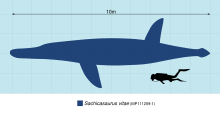Sachicasaurus
| Sachicasaurus Temporal range: Barremian
~ | |
|---|---|

| |
| Holotype specimen of Sachicasaurus. | |
| Scientific classification | |
| Domain: | Eukaryota |
| Kingdom: | Animalia |
| Phylum: | Chordata |
| Class: | Reptilia |
| Superorder: | †Sauropterygia |
| Order: | †Plesiosauria |
| Family: | †Pliosauridae |
| Subfamily: | †Brachaucheninae |
| Genus: | †Sachicasaurus |
| Species: | †S. vitae
|
| Binomial name | |
| †Sachicasaurus vitae Páramo Fonseca et al., 2019
| |
Sachicasaurus is an extinct genus of brachauchenine pliosaurid known from the Barremian of the Paja Formation, Altiplano Cundiboyacense in the Colombian Eastern Ranges of the Andes. The type species is S. vitae.
Etymology
The genus name Sachicasaurus refers to Sáchica, the village where the fossil was found, and saurus, meaning "lizard" in Greek. The species epithet vitae, meaning "life" in Latin, was chosen because of the life in Sáchica the fossil find has sparked.[1]
Description

Sachicasaurus was a large pliosaur, measuring 10–11 metres (33–36 ft) long and weighing 13.5 metric tons (14.9 short tons) as an adult.[2][3] The holotype specimen, MP111209-1, is known from a near complete skull, and postcranial elements including a complete hindlimb and various vertebrae. Diagnostic features include a very short mandibular symphysis, reduced number of mandibular teeth (17 to 18 versus 25 to 40 in other pliosaurids), slender teeth, among other features. With the preserved length estimated at almost 10 metres (33 ft), the specimen is interpreted as a sub-adult individual.[1]
Paleoenvironment
Sachicasaurus is one of four pliosaurids from the Paja Formation, others being Acostasaurus,[4] Stenorhynchosaurus,[5] and Monquirasaurus.[6] It is also contemporaneous with the elasmosaurids Callawayasaurus and Leivanectes,[7] the marine turtle Desmatochelys padillai,[8] the sandowniid turtle Leyvachelys,[9] and the ophthalmosaurid ichthyosaurs Muiscasaurus and Kyhytysuka.[10][11]
References
- ^ a b Páramo Fonseca, María Eurídice; Benavides Cabra, Cristian David; Gutiérrez, Ingry Esmirna (2018). "A new large pliosaurid from the Barremian (Lower Cretaceous) of Sáchica, Boyacá, Colombia". Earth Sciences Research Journal. 22 (4): 223–238. doi:10.15446/esrj.v22n4.69916. S2CID 135054193.
- ^ Spindler, F.; Mattes, M. (2021). "Einsame Spitze – Fakten und Spekulation über das Solnhofener Gipfelraubtier". Archaeopteryx. 37: 56–68.
- ^ Paul, Gregory S. (2022). The Princeton Field Guide to Mesozoic Sea Reptiles. Princeton University Press. p. 102.
- ^ Gómez Pérez & Noè, 2017
- ^ Páramo et al., 2016
- ^ Noè, L.F.; Gómez-Pérez, M. (2021). "Giant pliosaurids (Sauropterygia; Plesiosauria) from the Lower Cretaceous peri-Gondwanan seas of Colombia and Australia". Cretaceous Research. 132: 105122. doi:10.1016/j.cretres.2021.105122.
- ^ Páramo Fonseca et al., 2019
- ^ Cadena et al., 2015a
- ^ Cadena et al., 2015b
- ^ Maxwell et al., 2015
- ^ Cortés, D.; Maxwell, E.E.; Larsson, H.C.E. (2021). "Re-appearance of hypercarnivore ichthyosaurs in the Cretaceous with differentiated dentition: revision of Platypterygius sachicarum (Reptilia:Ichthyosauria, Ophthalmosauridae) from Colombia". Journal of Systematic Palaeontology. 19 (14): 969–1002. doi:10.1080/14772019.2021.1989507. S2CID 244512087.
Bibliography
- Sachicasaurus
- Other paleofauna










